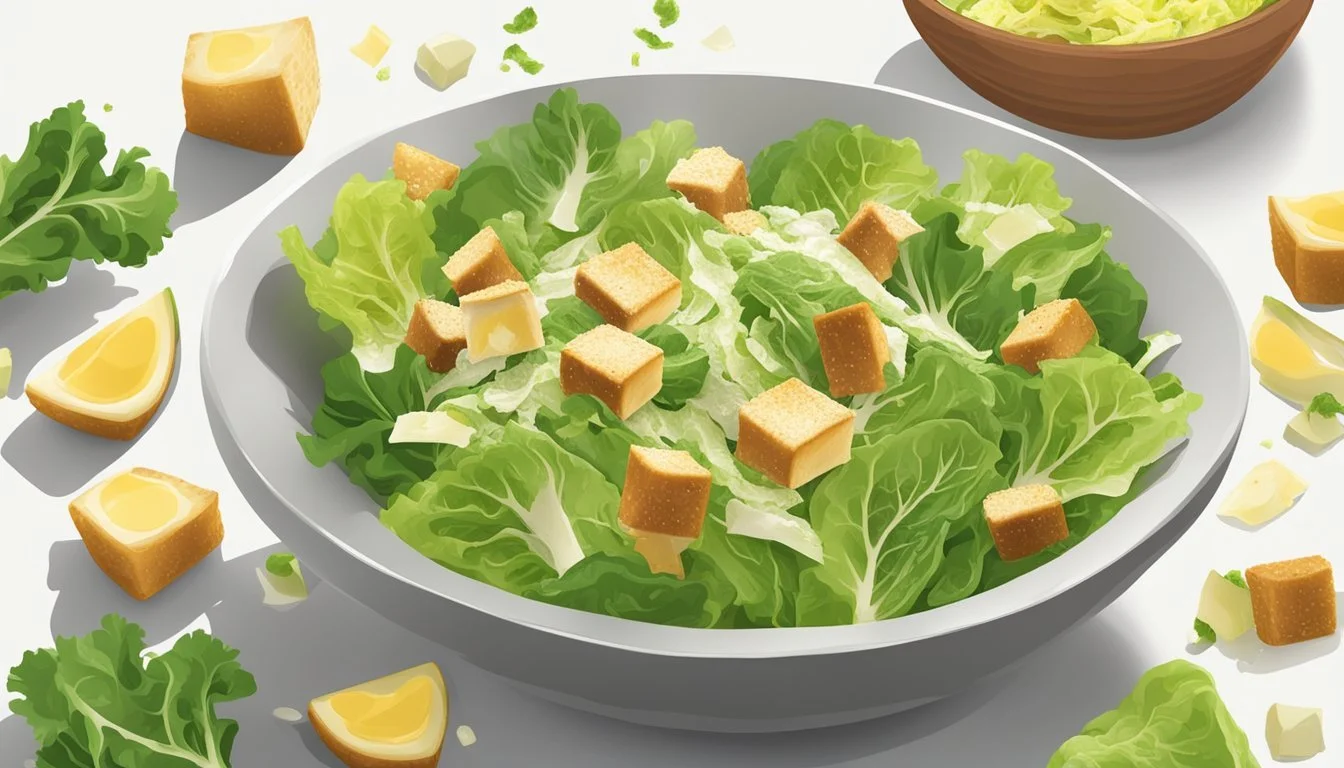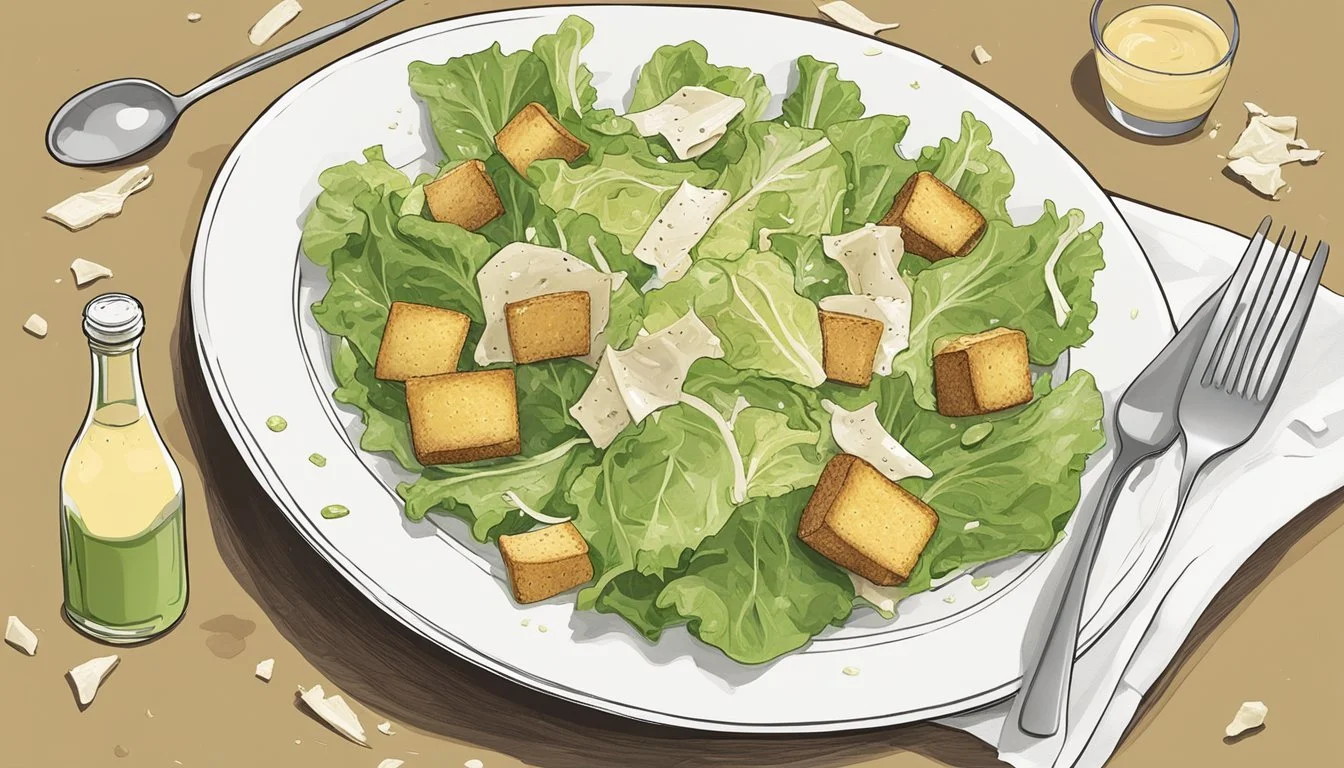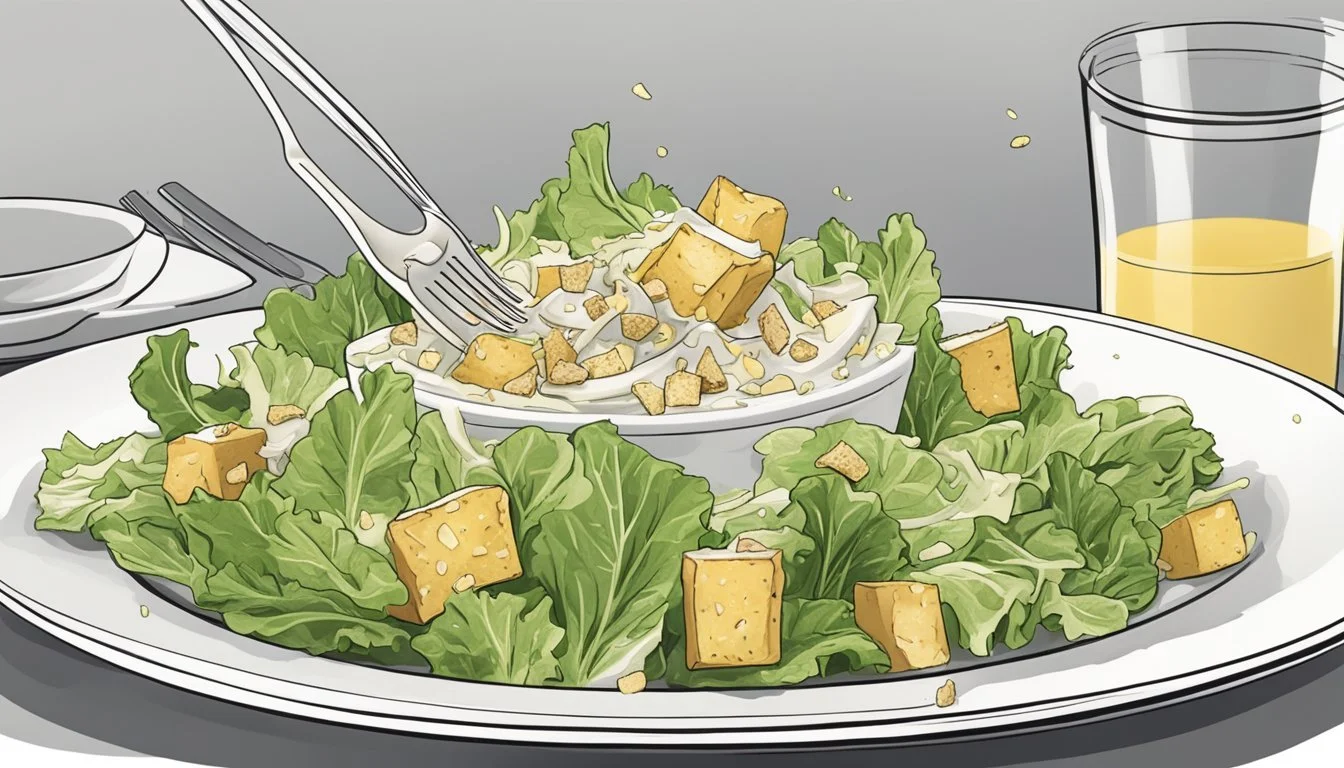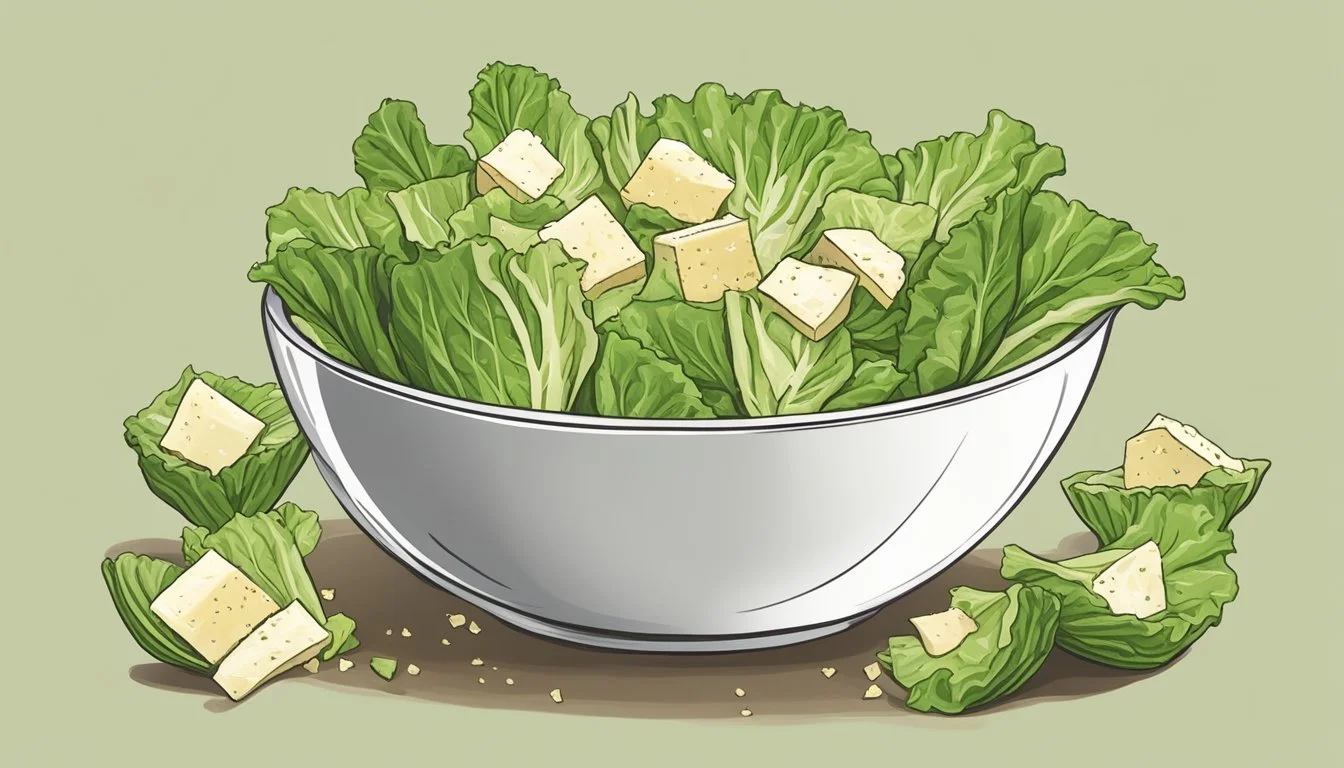How Do You Eat a Caesar Salad?
Mastering the Art of Enjoying This Classic Dish
Eating a Caesar salad is an experience that marries crisp textures with a rich, tangy dressing. The classic dish consists of romaine lettuce, croutons, Parmesan cheese, and Caesar dressing, which often includes ingredients such as lemon juice, garlic, egg yolks, and anchovies. (What wine goes well with anchovies?) One begins by ensuring that the lettuce is clean and properly dried, as moisture can repel the dressing, causing it to fail to adhere to the leaves effectively.
Before indulging, the components of a Caesar salad are mixed to ensure each bite is uniformly flavorful. A gentle toss is sufficient to coat the romaine leaves with dressing, creating the perfect backdrop for the savory crunch of the croutons and the salty umami from the shaved Parmesan cheese. The integration of these elements results in a harmonious combination that has secured the Caesar salad's place as a beloved staple in many dining scenarios.
For those enjoying the salad, it is customary to use a fork, navigating through the layers to capture a bit of each ingredient. The eating process is as simple or sophisticated as the diner prefers; some may opt for smaller bites that easily fit onto a fork, while others might fold larger leaves to create a bundle of flavors. Regardless of the method, the objective remains to appreciate the interplay of textures and tastes that characterize the Caesar salad.
History of Caesar Salad
The origins of Caesar salad can be traced back to Tijuana, Mexico. It was there, in the 1920s, that an Italian immigrant named Caesar Cardini invented the dish at his establishment, Caesar's Restaurant. The creation was said to have been the result of a Fourth of July rush, which depleted the kitchen's supplies, leading Cardini to create a salad from the ingredients that were still available.
Key Ingredients and Preparation:
Romaine lettuce: The base of the salad
Croutons: Added for crunch
Parmesan cheese: Grated over the top
Dressing: Traditionally made tableside with olive oil, lemon juice, egg, Worcestershire sauce, garlic, and black pepper
Caesar salad quickly grew in popularity, extending its reach beyond Mexico and into the United States. Julia Child recounted an experience of eating Caesar salad at Cardini's restaurant in her youth, which contributed to the dish's growth in prominence. By the 1940s, the Caesar salad had become a staple at many fine dining establishments across the world, garnering acknowledgment from Gourmet Magazine and becoming cemented as a culinary classic.
The salad remains widely popular today, often served as a starter dish and praised for its robust flavor profile and its interplay of textures. Despite its widespread fame, the original recipes and preparation methods remain closely associated with Caesar's Restaurant, a testament to the enduring legacy of Caesar Cardini's creation.
Key Ingredients
A Caesar salad's success hinges on the quality and freshness of its key ingredients. These components come together to create a balance of flavors and textures, each playing a crucial role in the overall taste of the dish.
Romaine Lettuce
Romaine lettuce is the foundation of a Caesar
Preparing the Salad
The foundation of an impeccable Caesar salad rests on fresh, crisp romaine lettuce, a zesty homemade dressing, and golden, crunchy croutons. Each component requires attention to detail for the best flavor and texture.
Washing and Drying Lettuce
To ensure the lettuce retains its crispness, it must be thoroughly washed and dried. One can chop the romaine lettuce into bite-sized pieces and rinse them under cool water. The effectiveness of a salad spinner cannot be overstated here; it quickly removes excess moisture. Alternatively, spreading the lettuce on a clean kitchen towel and patting dry also does the trick. The key is to start with completely dry lettuce so the Caesar dressing adheres well.
Making Homemade Dressing
A classic Caesar dressing enriches the salad with its creamy texture and bold flavors. The recipe usually includes anchovies, garlic, grated Parmesan cheese, and a squeeze of fresh lemon juice. Incorporate a neutral oil, like vegetable oil, through a whisk to emulsify the ingredients into a smooth dressing. The homemade dressing's freshness and absence of preservatives enhance the overall flavor profile of the Caesar salad.
Baking Croutons
Homemade garlic croutons add a satisfying crunch and aromatic garlic notes to the Caesar salad. Cut day-old bread into cubes and toss with a blend of melted butter, crushed garlic, and a pinch of salt. Bake in an oven preheated to 375°F (190°C) until golden and crisp. Once cooled, store the croutons in an airtight container to maintain their crunch until ready to serve.
Recipe Variations
Caesar salad is a versatile dish that can be customized in numerous ways to suit different tastes and occasions. By altering the proteins, greens, and additional toppings, one can transform the classic Caesar into a variety of flavorful creations.
Protein Additions
The classic Caesar salad often features chicken breast as a protein choice due to its lean nature and ability to absorb the dressing flavors. For a heartier version, they may consider salmon or shrimp which not only enrich the dish with omega-3 fatty acids but also add a unique taste profile. Vegetarian options might include chickpeas or black beans. For a more indulgent approach, crispy bacon pieces can be a savory addition.
Alternative Greens
While Romaine is the traditional choice for Caesar salads (What wine goes well with salads?), alternative greens like kale offer a hearty texture and a nutritional boost. Kale retains its crispness for an extended time, making it an excellent choice for Caesar pasta salads that may sit in dressing longer. Incorporating greens like spinach or arugula provides distinct flavors and an array of vitamins and minerals.
Extra Toppings
Extra toppings can elevate a Caesar salad from a side to a main dish. Avocado slices add creaminess and healthy fats, while tomatoes bring a fresh, acidic note to the salad. Homemade Caesar salad dressing, enriched with garlic and anchovy paste, can heighten the flavor far beyond that of store-bought versions. Sprinkling homemade garlic butter breadcrumbs adds crunch and can replace traditional croutons for a unique twist.
Serving the Caesar Salad
When serving a Caesar salad, presentation and accompaniments can enhance the dining experience. Proper plating techniques showcase the dish's components, while thoughtful additions complement the flavors.
Plating Techniques
The salad should be served on chilled plates to maintain the crispness of the lettuce. One should drizzle the Caesar dressing evenly over the romaine lettuce, ensuring each leaf is lightly coated. To add a touch of elegance, a vegetable peeler could be used to shave Parmesan cheese over the top, and kosher salt and freshly cracked black pepper can be sprinkled to season.
Accompaniments
Caesar salad can be enjoyed as a side salad or as the main course. If served as a side, it pairs well with dishes like Spicy Penne Vodka or simply grilled chicken. As a stand-alone meal, adding protein such as grilled chicken strips or anchovies completes the dish. For a finishing touch, extra-virgin olive oil can be drizzled and homemade garlic croutons can be scattered on top for additional texture and taste.
Food Safety Tips
When preparing or consuming Caesar salads, safety must be a top priority due to the inclusion of raw egg yolks in the dressing. The danger here stems from the potential presence of Salmonella bacteria, which can cause foodborne illness.
Egg Safety: To minimize the risk of Salmonella, one should opt for pasteurized eggs. Pasteurization involves heating the eggs to a specific temperature to destroy harmful bacteria without cooking the egg. Using pasteurized eggs for the dressing can help ensure the safety of the salad without sacrificing the traditional creamy texture.
Storage: Properly storing the salad is crucial. The salad should be kept chilled, and any unused portions need to be refrigerated promptly. It is advisable to consume the salad soon after preparation. If the salad has been left out at room temperature for more than two hours, it should be discarded to prevent the growth of bacteria.
Handling Tips:
Always wash hands with soap and water before handling ingredients.
Use clean utensils and cutting boards to prepare the salad.
Keep the salad and its ingredients separate from raw meat to avoid cross-contamination.
Chilling: Caesar salad should be served chilled. This not only maintains freshness but also inhibits bacterial growth. When transporting, one should employ coolers or ice packs to keep the salad cold.
By following these guidelines, consumers can enjoy Caesar salads while effectively managing food safety risks.
Storage and Leftovers
When storing Caesar salad as leftovers, proper containment is key. The salad should be placed in an airtight container to maintain freshness and prevent the greens from wilting. To further extend the life of the salad, one can line the container with a paper towel to absorb excess moisture.
For optimal preservation, Caesar salad should be refrigerated at 40 degrees Fahrenheit or lower. This temperature range inhibits bacterial growth and keeps the salad safe to consume. It's crucial to remember that dressed salads tend to deteriorate faster due to the dressing breaking down the structure of the greens. Therefore, if possible, dressing should be stored separately and added just before serving.
Here's a simplified guide to storage times:
Undressed Caesar Salad: Up to one week if refrigerated in an airtight container with a paper towel.
Dressed Caesar Salad: Best if consumed within a day; however, it might last up to three days under optimal refrigeration.
For reheating any chicken or protein included in a leftover Caesar salad, ensure it reaches an internal temperature of 165 degrees Fahrenheit to ensure safety.
Storing Chicken: Keep refrigerated and consume within three to five days.
Lastly, freezing Caesar salad is not recommended due to the salad's high moisture content, which will result in an unpleasant texture upon thawing.
Nutritional Information
When assessing the nutritional content of a Caesar salad, it is crucial to consider the individual components that comprise the dish. The core ingredient, romaine lettuce, is low in calories and provides fiber, vitamin A, and vitamin K.
Caesar dressing, typically rich in fat due to ingredients like oil, Parmesan cheese, and sometimes egg yolks, can significantly increase the calorie content of the salad. For a healthier option, one might opt for a "light" dressing, though they should be aware of potential sodium levels.
The addition of croutons adds carbohydrates and calories, and their nutritional contribution varies depending on the type and amount used. Parmesan cheese, another essential component, increases the content of both saturated fat and protein per serving.
Here is a breakdown of typical nutritional values for a standard Caesar salad serving:
Nutrient Amount Calories 300-800 Total Fat 40g Saturated Fat 8.2g Trans Fat 0.1g Polyunsaturated Fat 19g Monounsaturated Fat 10g Sodium Varies Total Carbohydrate Varies Dietary Fiber Varies Sugars Varies Protein Varies Vitamins and Minerals Varies
It should be noted that these values can fluctuate based on the salad's portion size and specific ingredients used. For instance, adding grilled chicken or bacon will change the protein and fat composition. Wherever possible, individuals should tailor the components of their Caesar salad to align with their dietary goals and restrictions.
Dining Etiquette
When enjoying a Caesar salad, diners should be mindful of their table manners to ensure a pleasant meal experience for themselves and their company.
Cutting the Salad: Patrons should use their knife to cut one or two bites of salad at a time—cutting the entire salad at once is considered uncouth. It is proper to handle the knife with the right hand and the fork with the left hand while cutting. After cutting, the knife should be placed on the edge of the plate, and the fork transferred to the right hand for eating, if that is the diner's dominant hand.
Using Napkins: The napkin serves as a silent signal. Before the first bite, the diner unfolds the napkin and places it on their lap. If one needs to leave the table temporarily, they should place the napkin on their chair as a sign of return.
Fork Technique: There are two primary methods for using a fork:
Piercing: The diner can pierce individual pieces of lettuce and croutons.
Scooping: The diner gathers a small stack of salad components, ideally without it toppling, before bringing the fork to their mouth.
Observing Utensil Order: Generally, it is advisable to start with the utensil placed farthest from the plate which is commonly the salad fork. The sequential use of utensils from the outside in reflects good manners and a clear understanding of dining etiquette.
The diner should eat at a leisurely pace, matching the speed of their fellow diners to maintain harmony at the dining table. Loud chewing or slurping dressing from utensils is deemed impolite, so one should consume their salad quietly and with small bites.
Making Caesar Salad Ahead of Time
Preparing a Caesar salad in advance is quite straightforward and can save time for those with a busy schedule. One can confidently assemble a Caesar salad ahead with a few simple steps to ensure that the ingredients remain fresh and crisp.
Ingredients Separation:
It's essential to store ingredients separately to maintain their distinct textures. The lettuce, dressing, croutoons, and Parmesan cheese should be kept in different containers.
Lettuce: Wash and dry the leaves thoroughly. Moisture leads to a soggy salad, hence ensure they're completely dry. Store in the refrigerator in an airtight container.
Dressing: Store the Caesar dressing separately, preferably in a jar or container with a tight-fitting lid in the fridge.
Croutons: Avoid adding croutons until ready to serve as they will soften. Bake or buy them ahead, and keep at room temperature in a sealed bag.
Assembly:
When it's time to serve, combine the well-chilled and dry lettuce with the desired amount of dressing. Toss until the leaves are evenly coated. Add Parmesan cheese, and finally, top with croutons to maintain their crunch.
Storage Timeline:
Lettuce: Can be stored in the refrigerator for up to 5 days.
Dressing: Generally lasts well for about a week when refrigerated.
Croutons: Remain fresh at room temperature for several days.
By adhering to these instructions, one can enjoy a Caesar salad that's as fresh and flavorful as if it were made moments ago.
Popular Culture and Caesar Salad
The Caesar salad has left an indelible mark on popular culture, finding its way into social media trends and the repertoires of celebrity chefs. It's celebrated for its robust flavor and versatility, an icon in the culinary world that transcends geographical boundaries.
Influence on Social Media
Facebook, Instagram, and Pinterest have become platforms where the Caesar salad enjoys considerable popularity. Users on Instagram often share high-definition images of their homemade Caesar salads, employing hashtags like #CaesarSalad to broaden their reach. On Pinterest, one can find numerous pins and boards dedicated to variations of the Caesar salad, with detailed recipe instructions and presentation tips. Facebook groups are formed where members exchange tips on how to perfect the classic dish or share versions incorporating regional ingredients.
Celebrity Chefs and Caesar Salad
Julia Child, a stalwart in the culinary world, has often included the Caesar salad in her cooking shows and books, solidifying its status. She demystified the recipe for countless viewers and has been pivotal in popularizing the dish among the home cooks. Modern celebrity chefs frequently feature Caesar salad on their TV shows and social media, often adding their signature twist to the iconic dish. They also contribute to the evolving narrative surrounding the salad, praising its classic version while also encouraging personal innovation.
Buying Guide for Ingredients
When shopping for ingredients to create a Caesar salad, selecting high-quality components at the grocery store is paramount.
Romaine Lettuce: Look for fresh, crisp leaves. They should be bright green with no signs of wilting or browning. Organic options often provide the best flavor.
Anchovies: Purchase anchovies that are stored in olive oil as they tend to be of higher quality and have a superior taste. They generally come in jars or tins.
Parmesan Cheese: Opt for blocks of authentic Parmigiano-Reggiano which you can grate freshly over the salad for the boldest flavor.
Croutons: While store-bought croutons are convenient, consider buying artisan bread to make your own for a homemade touch.
Dressing Ingredients:
Lemons: Choose plump lemons with firm skin as they'll yield more juice.
Worcestershire Sauce: A staple in this dressing, go for well-known brands that ensure consistency in taste.
Garlic: Fresh garlic cloves will provide the best taste compared to pre-minced variants.
Dijon Mustard & Capers: (What wine goes well with capers?) These add depth to the dressing. Their quality can greatly influence the overall taste of the salad.
Extra Tip: Acquiring organic ingredients might uplift the overall taste and quality of your salad. Below is a simple checklist to ensure no ingredient is forgotten:
Ingredient Quality Check Romaine Lettuce Fresh, green, crisp leaves Anchovies Stored in olive oil Parmesan Cheese Block of Parmigiano-Reggiano Artisan Bread For homemade croutons Lemons Plump with firm skin Worcestershire Sauce Established brand Garlic Fresh cloves Dijon Mustard Quality brand Capers Nonpareil or in vinegar/brine
A thorough selection will ensure your Caesar salad is of the highest quality, marrying flavors harmoniously.













